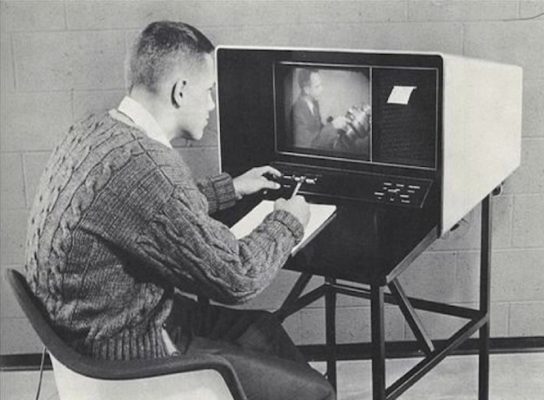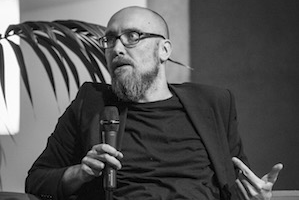Search
To search for an exact match, type the word or phrase you want in quotation marks.
A*DESK has been offering since 2002 contents about criticism and contemporary art. A*DESK has become consolidated thanks to all those who have believed in the project, all those who have followed us, debating, participating and collaborating. Many people have collaborated with A*DESK, and continue to do so. Their efforts, knowledge and belief in the project are what make it grow internationally. At A*DESK we have also generated work for over one hundred professionals in culture, from small collaborations with reviews and classes, to more prolonged and intense collaborations.
At A*DESK we believe in the need for free and universal access to culture and knowledge. We want to carry on being independent, remaining open to more ideas and opinions. If you believe in A*DESK, we need your backing to be able to continue. You can now participate in the project by supporting it. You can choose how much you want to contribute to the project.
You can decide how much you want to bring to the project.

One of the most persistent things that “new” media arts have actually cocooned during their decades of Post WWII development is an appreciation of the obsolete, old and analogue. It is such a paradox, one however which makes the whole issue of media arts more interesting: that the new is potentially less interesting than how the old is remediated, recycled, recursively represenced. Media art that employs the newest technologies does not necessarily match up to the innovative ways of digging up old ideas, imaginary media solutions and obsolete analogue technologies as ways to demonstrate that our culture is not – and should not – be based on a one-track assumption of linear progress. What if the parallel existence of the other reality alongside the glitzy digital – the world of “zoetropes, kinetoscopes, stereoscopes, phonographs, pinball machines, fortune-telling machines, periscopes and guns, household appliances, vintage television sets, even obsolete computers and videogames” (Huhtamo 1995)[[ Huhtamo, Erkki (1995) “Resurrecting the Technological Past. An Introduction to the Archaeology of Media Art”. InterCommunication, nº 14, 1995. http://www.ntticc.or.jp/pub/ic_mag/ic014/huhtamo/huhtamo_e.html]] is as important as how such old technologies persist in media art, galleries, curatorial programmes and popular culture?
We learn from the old when the seemingly new is emerging, while at the same time being open to realizing the “old in the new” and the “new in the old” to borrow words from Siegfried Zielinski (2006)[[ Zielinski, Siegfried (2006) The Deep Time of the Media. Towards and Archaeology of Seeing and Hearing by Technical Means. Trans. Gloria Custance. (Cambridge, MA: The MIT Press). ]]. Media archaeology is itself a sort of excavation of lost ideas, alternative histories and the conditions of existence of media. In other words, the role of media archaeology has been to offer artistic projects and methodological ideas how to learn more about the deeper archaeological layers and complex genealogies of our supposedly new inventions. In that sense, there are many ways to approach media archaeology as part of media art history.
Several influential media archaeologists, such as Zielinski and Erkki Huhtamo, have worked closely with artists and designers also in institutional settings, which has left its mark on both students adopting media-archaeological methods, and scholars’ work. Thematically, media archaeology became a key topic in the 1990s. Similar ideas were developed by earlier theorists, such as Walter Benjamin, Siegfried Giedion and others, before the term existed. But it was scholars such as Zielinski, Huhtamo, Thomas Elsaesser, Friedrich Kittler, Anne Friedberg and others who contributed to the cinema and media historical methodology in ways that worked it into an exciting field. In Zielinski’s earlier translated work, Audiovisions, he emphasizes it as a way to understand the cultural underpinnings of artefacts and technology: “technology is not an accidental outflow of cultural determinants, which on their part condition the existence, consciousness, and unconsciousness of the subjects in a one-dimensional way.” (Zielinski 1999, 20)[[ Zielinski, Siegfried (1999). Audiovisions. Cinema and Television as Entr’actes in History. Trans. Gloria Custance. (Amsterdam, Amsterdam University Press). ]]. Zielinski’s work grew out of thinking of alternative paths to cinema and television history to emphasise the interactions between technology, culture and subject-formation. It led to investigations of artistic work that branded the media art historically significant works in avant-garde electronics: Nam June Paik, Steina and Woody Vasulka, Valie Export, David Larcher, etc.
It becomes clear from the writings of media archaeologists such as Zielinski and Huhtamo that the experimental cinema worlds of 1970s and 1980s (e.g. Jean-Luc Godard and his History of Cinema-project) had a huge impact on scholarly themes. It was the time of increased amounts of cinematic pieces that somehow addressed the earlier audiovisual forms of early and precinema: Ken Jacobs’ work, including Tom, Tom the Piper’s Son (1969), worked through early cinema and it also coined the idea of “paracinema”; Edward Muybridge’s (1830-1904) serial photography was rediscovered in the 1970s having an impact in audiovisual expression and historical interest and in academic writing, the earlier mentioned New Film History refocused to the pre-cinematic period and to new methods. (Huhtamo 2015)[[ Huhtamo, Erkki (2015). “Art in the Rear-View Mirror: the Media Archaeological Tradition in Art”, in: Blackwell Companion to Digital Art, ed. Christiane Paul (Wiley-Blackwell). ]]. Video art and electronic art pioneers before the digital were as influential in outlining man-machine relations that characterized the new cybernetic era and its artistic themes. Besides cybernetics, the audiovisual was also an important theme. In parallel to Huhtamo and Zielinski, in the 1980s New Film History developed a sort of a media archaeological method which addressed the assumed ruptures between pre-cinema, early cinema and narrative cinema and which methodologically ranged “from questioning what is taken for granted or accepted as “truth” to digging up forgotten pioneers, unimportant films and other neglected material or dimensions.” (Strauven 2013, 83)[[ Strauven, Wanda (2013) “Media Archaeology: Where Film History, Media Art, and New Media (Can) Meet)”. In: Julia Noordegraaf, Cosetta Saba, Barbara Le Maitre, and Vinzenz Hediger (eds.), Preserving and Exhibiting Media Art Challenges and Perspectives (Amsterdam: Amsterdam University Press), pp. 59-79. ]].
Media archaeology and media art history could be said to share some of the motivation that comes from the early rethinking of art history as image science. The German tradition of Bildwissenschaft was, after all, interested in neglected stories left outside the canon of art history and taking into account the technical basis of the arts: “to write the history of the evolution of the visual media, from peep show to panorama, anamorphosis, myriorama, stereoscope, cyclorama, magic lantern, eidophusikon, diorama, phantasmagoria, silent movies, films with scents and colors, cinéorama, IMAX, television, telematics, and the virtual image spaces generated by computers. It is a history that also includes a host of typical aberrations, contradictions, and dead ends.” (Grau 2007, 11)[[ Grau, Oliver (2007) “Introduction” In: Oliver Grau (ed.) Mediaarthistories. (Cambridge, MA:The MIT Press), pp.1-14.]].
But it’s important to underline how the media artists themselves worked as media archaeologists. It was this “against the grain” attitude (to use Geert Lovink’s words) that was also present in a lot of media arts in the context of the digital: to look at the analogue technologies, to approach the new through a rear view mirror (McLuhan’s metaphor, see also Huhtamo 2015) and to understand that innovation was not only about responding reactively to the new technologies but to develop critical temporal situations.
The media arts scene and theoretical reflection reinforced each other. This earlier wave itself had an inspiring effect on a more recent generation of practitioners who have picked up on the impulse. One significant name who develops media archaeological ideas in relation to critical design is Garnet Hertz, a Canadian artist/writer whose dead media lab has become a hub for various activities that develop ideas which rework the obsolete into something functional and interesting. He is also someone who has tried to underline that we need to understand the discourses of dead media and the obsolete not merely in relation to archiving old technologies but also for the discarded electronic waste that is a growing environmental problem. Together with Hertz we wrote a sort of a manifesto for media archaeological art titled “Zombie Media” (2012)[[ Hertz, Garnet and Parikka, Jussi (2012) “Zombie Media: Circuit Bending Media Archaeology into an Art Method”. Leonardo Vol. 45, Nº 5, pp. 424-430.]] where we addressed artistic repurposing, circuit bending and using obsolete material as ways to engage with the past in the present.
The notion of “new” or “contemporary” are relative to their historical and geographical contexts, with a growing need to be aware of the long media art histories outside the usual Anglo-American or Central-European focus. Media arts’ place as part of new media culture is itself something to be questioned when we start to understand how crucial it is to comprehend the long genealogies of our inventions and ideas. It is in this sense that the “historical” interest of knowledge is not merely about the past and writing histories – but about articulating the contemporary as a meeting place of temporal directions: the new, old, ruptured moment of now.
The increasing acceleration of production of technological gadgets and other novelties is also producing a growing pile of obsolete media technologies which signal the era of “dead media” (Bruce Sterling’s term) as one that is increasingly growing. It means a material waste load and an accelerated pace of invention-obsolescence also in terms of the potentials of amnesia. The things that seem new – such as the historical proclamation of the “data super-highway” in the 1992 presential campaign by Clinton and Gore was preceded by Nam June Paik’s use of the term “electronic superhighway” in 1974 (Daniels 2009, 16-17)[[ Daniels, Dieter (2009) “Reverse Engineering Modernism with the Last Avant-Garde”. In Dieter Daniels and Gunther Reisinger (eds.), Net Pioneers 1.0. Contextualizing Early Net-Based Art. Berlin: Sternberg Press, pp. 15-62. ]]. Many of the novelties having to do with internet hype had their precursors in artistic and community experiments of the 1970s and the 1980s. A lot of the historical work is now being recognized in initiatives to archive the heritage of internet and media arts – and it is also paired with the theoretical work that contributes to media archaeology (See also Ernst 2013)[[ Erns, Wolfgand (2013) Digital Memory and the Archive. Ed. With an introduction by Jussi Parikka. (Minneapolis: University of Minnesota Press). ]] In other words, as media archaeologists, we need to understand how the new is almost always, already old and to tirelessly ask what really is politically new when it comes to the role of media cultural invention when we might be better off talking about the age of increasing obsolescence of technological devices.
*Revised version of an earlier piece published in Post Digital Histories, ed. Ekmel Ertan Akbanksanat and Amber Festival, Istanbul, 2015.

[Jussi Parikka was born in Finland, and is part of the generation that still remembers fondly the final years of the welfare state. Various travels took him to the UK where he teaches and writes at the Winchester School of Art. The particular interest in media out of place, media obsolete and technology that is not merely glitzy and perfectly functioning or even digital has persisted for years.
"A desk is a dangerous place from which to watch the world" (John Le Carré)